Corporate and Financial Accounting Australia Report 2022
VerifiedAdded on 2022/10/15
|16
|3122
|19
AI Summary
Contribute Materials
Your contribution can guide someone’s learning journey. Share your
documents today.
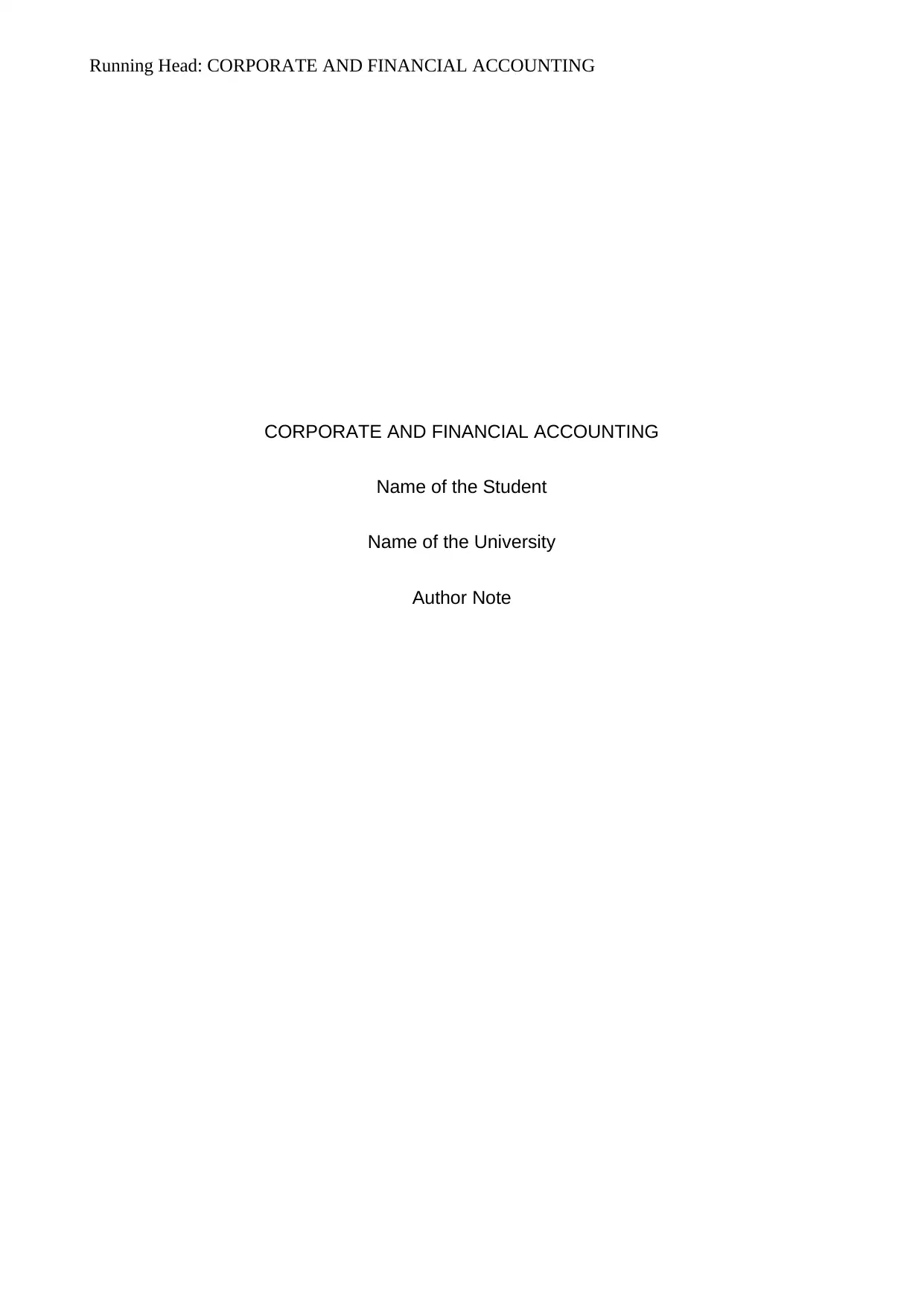
Running Head: CORPORATE AND FINANCIAL ACCOUNTING
CORPORATE AND FINANCIAL ACCOUNTING
Name of the Student
Name of the University
Author Note
CORPORATE AND FINANCIAL ACCOUNTING
Name of the Student
Name of the University
Author Note
Secure Best Marks with AI Grader
Need help grading? Try our AI Grader for instant feedback on your assignments.
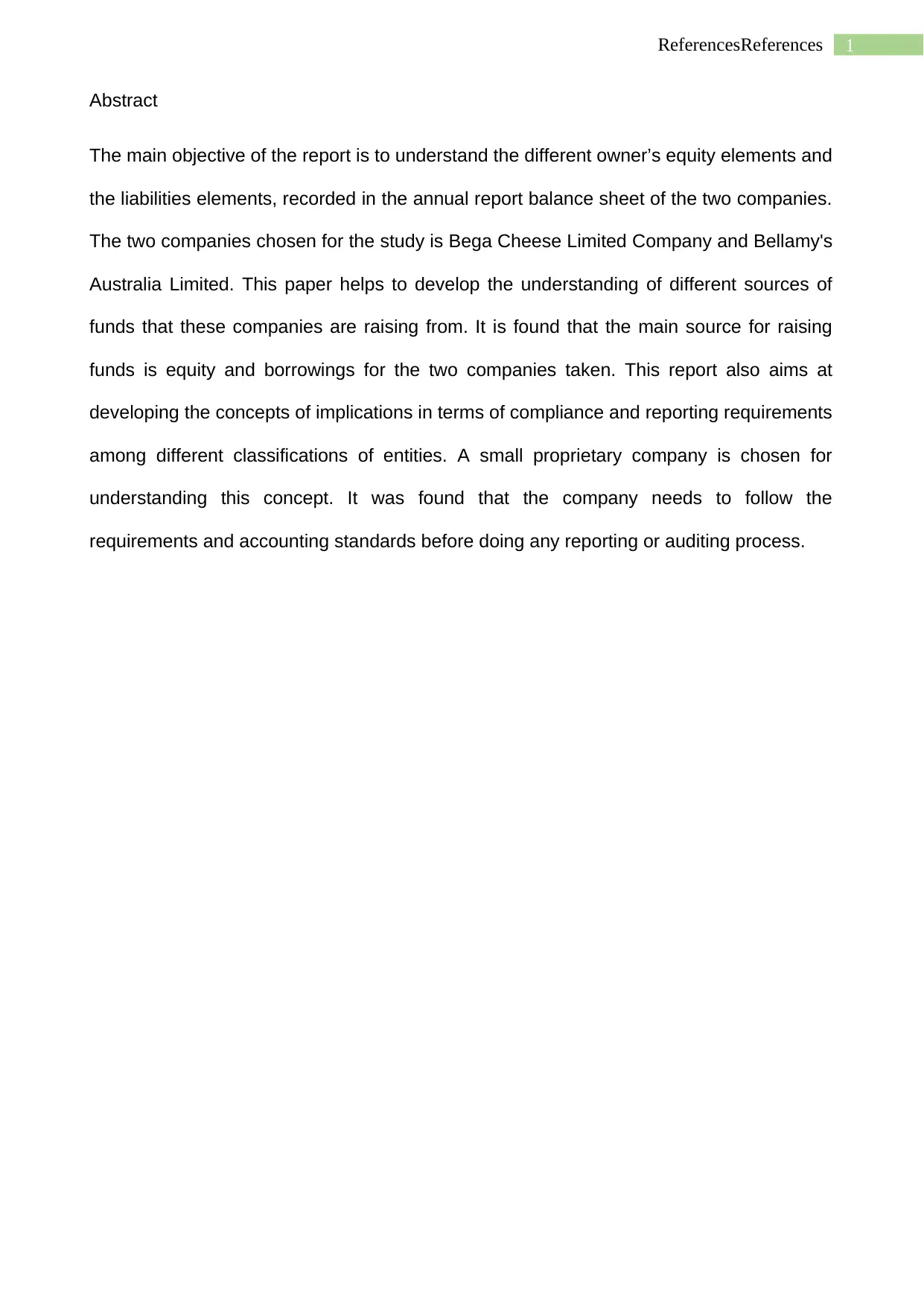
1ReferencesReferences
Abstract
The main objective of the report is to understand the different owner’s equity elements and
the liabilities elements, recorded in the annual report balance sheet of the two companies.
The two companies chosen for the study is Bega Cheese Limited Company and Bellamy's
Australia Limited. This paper helps to develop the understanding of different sources of
funds that these companies are raising from. It is found that the main source for raising
funds is equity and borrowings for the two companies taken. This report also aims at
developing the concepts of implications in terms of compliance and reporting requirements
among different classifications of entities. A small proprietary company is chosen for
understanding this concept. It was found that the company needs to follow the
requirements and accounting standards before doing any reporting or auditing process.
Abstract
The main objective of the report is to understand the different owner’s equity elements and
the liabilities elements, recorded in the annual report balance sheet of the two companies.
The two companies chosen for the study is Bega Cheese Limited Company and Bellamy's
Australia Limited. This paper helps to develop the understanding of different sources of
funds that these companies are raising from. It is found that the main source for raising
funds is equity and borrowings for the two companies taken. This report also aims at
developing the concepts of implications in terms of compliance and reporting requirements
among different classifications of entities. A small proprietary company is chosen for
understanding this concept. It was found that the company needs to follow the
requirements and accounting standards before doing any reporting or auditing process.
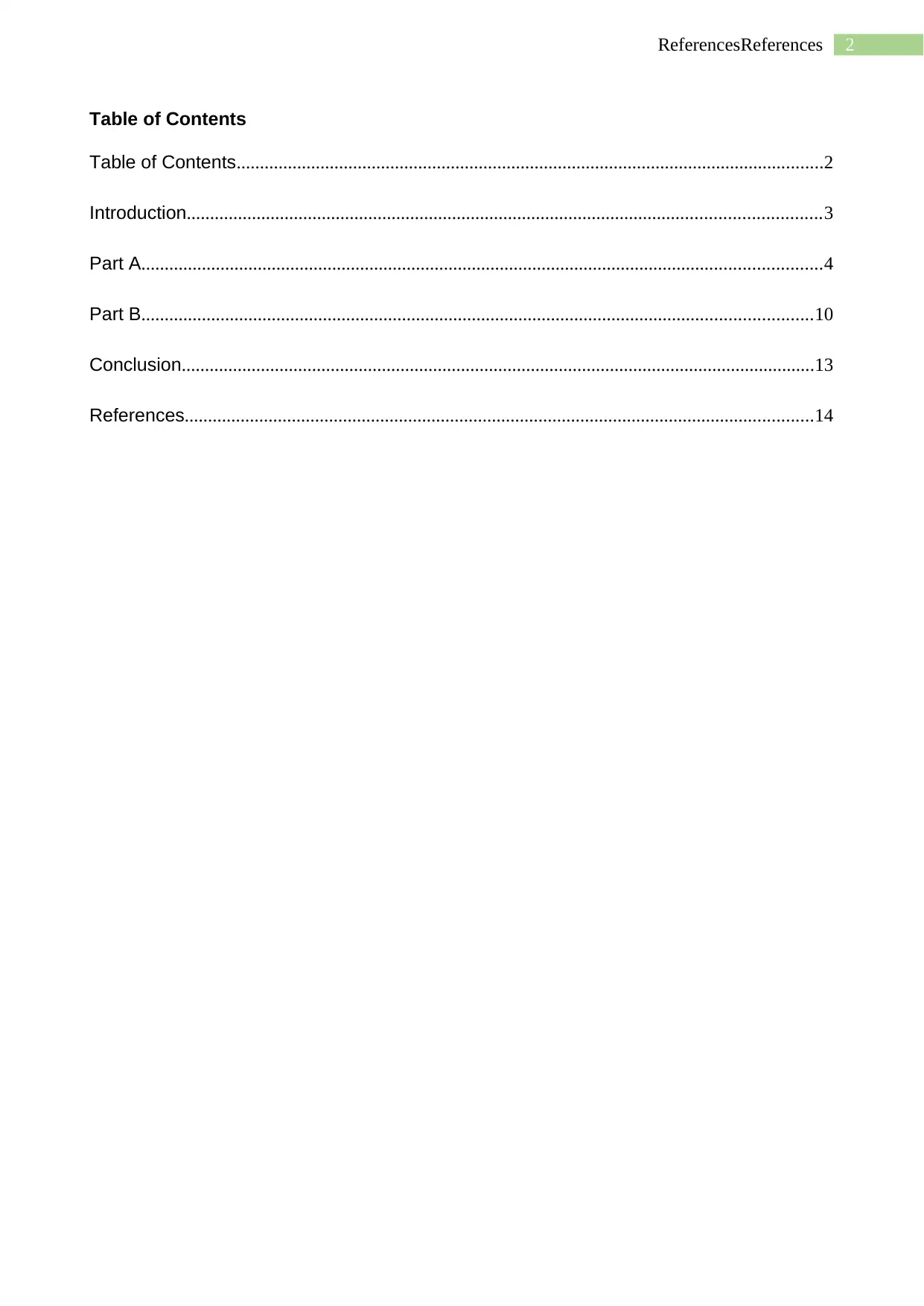
2ReferencesReferences
Table of Contents
Table of Contents..............................................................................................................................2
Introduction........................................................................................................................................3
Part A..................................................................................................................................................4
Part B................................................................................................................................................10
Conclusion........................................................................................................................................13
References.......................................................................................................................................14
Table of Contents
Table of Contents..............................................................................................................................2
Introduction........................................................................................................................................3
Part A..................................................................................................................................................4
Part B................................................................................................................................................10
Conclusion........................................................................................................................................13
References.......................................................................................................................................14
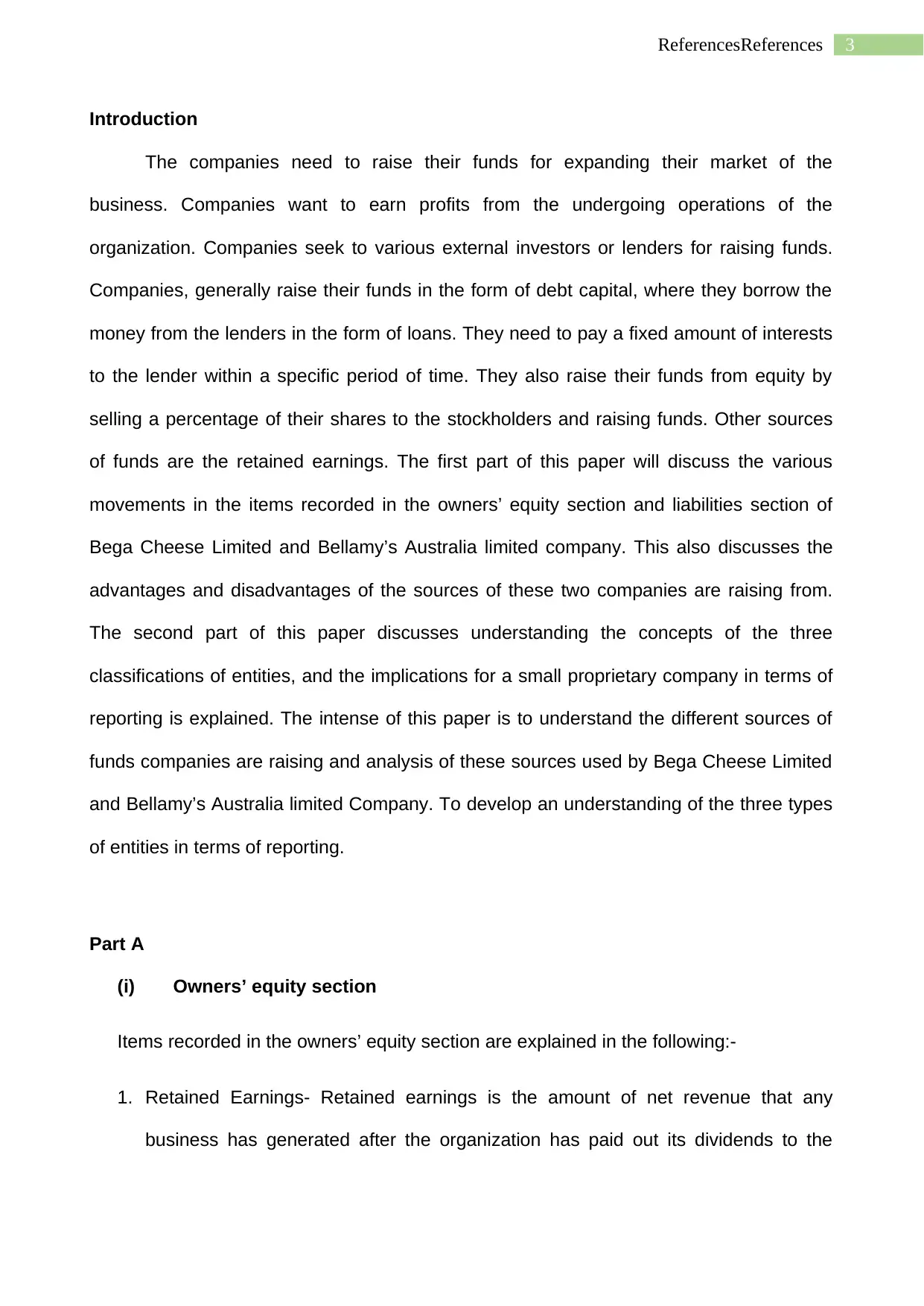
3ReferencesReferences
Introduction
The companies need to raise their funds for expanding their market of the
business. Companies want to earn profits from the undergoing operations of the
organization. Companies seek to various external investors or lenders for raising funds.
Companies, generally raise their funds in the form of debt capital, where they borrow the
money from the lenders in the form of loans. They need to pay a fixed amount of interests
to the lender within a specific period of time. They also raise their funds from equity by
selling a percentage of their shares to the stockholders and raising funds. Other sources
of funds are the retained earnings. The first part of this paper will discuss the various
movements in the items recorded in the owners’ equity section and liabilities section of
Bega Cheese Limited and Bellamy’s Australia limited company. This also discusses the
advantages and disadvantages of the sources of these two companies are raising from.
The second part of this paper discusses understanding the concepts of the three
classifications of entities, and the implications for a small proprietary company in terms of
reporting is explained. The intense of this paper is to understand the different sources of
funds companies are raising and analysis of these sources used by Bega Cheese Limited
and Bellamy’s Australia limited Company. To develop an understanding of the three types
of entities in terms of reporting.
Part A
(i) Owners’ equity section
Items recorded in the owners’ equity section are explained in the following:-
1. Retained Earnings- Retained earnings is the amount of net revenue that any
business has generated after the organization has paid out its dividends to the
Introduction
The companies need to raise their funds for expanding their market of the
business. Companies want to earn profits from the undergoing operations of the
organization. Companies seek to various external investors or lenders for raising funds.
Companies, generally raise their funds in the form of debt capital, where they borrow the
money from the lenders in the form of loans. They need to pay a fixed amount of interests
to the lender within a specific period of time. They also raise their funds from equity by
selling a percentage of their shares to the stockholders and raising funds. Other sources
of funds are the retained earnings. The first part of this paper will discuss the various
movements in the items recorded in the owners’ equity section and liabilities section of
Bega Cheese Limited and Bellamy’s Australia limited company. This also discusses the
advantages and disadvantages of the sources of these two companies are raising from.
The second part of this paper discusses understanding the concepts of the three
classifications of entities, and the implications for a small proprietary company in terms of
reporting is explained. The intense of this paper is to understand the different sources of
funds companies are raising and analysis of these sources used by Bega Cheese Limited
and Bellamy’s Australia limited Company. To develop an understanding of the three types
of entities in terms of reporting.
Part A
(i) Owners’ equity section
Items recorded in the owners’ equity section are explained in the following:-
1. Retained Earnings- Retained earnings is the amount of net revenue that any
business has generated after the organization has paid out its dividends to the
Secure Best Marks with AI Grader
Need help grading? Try our AI Grader for instant feedback on your assignments.
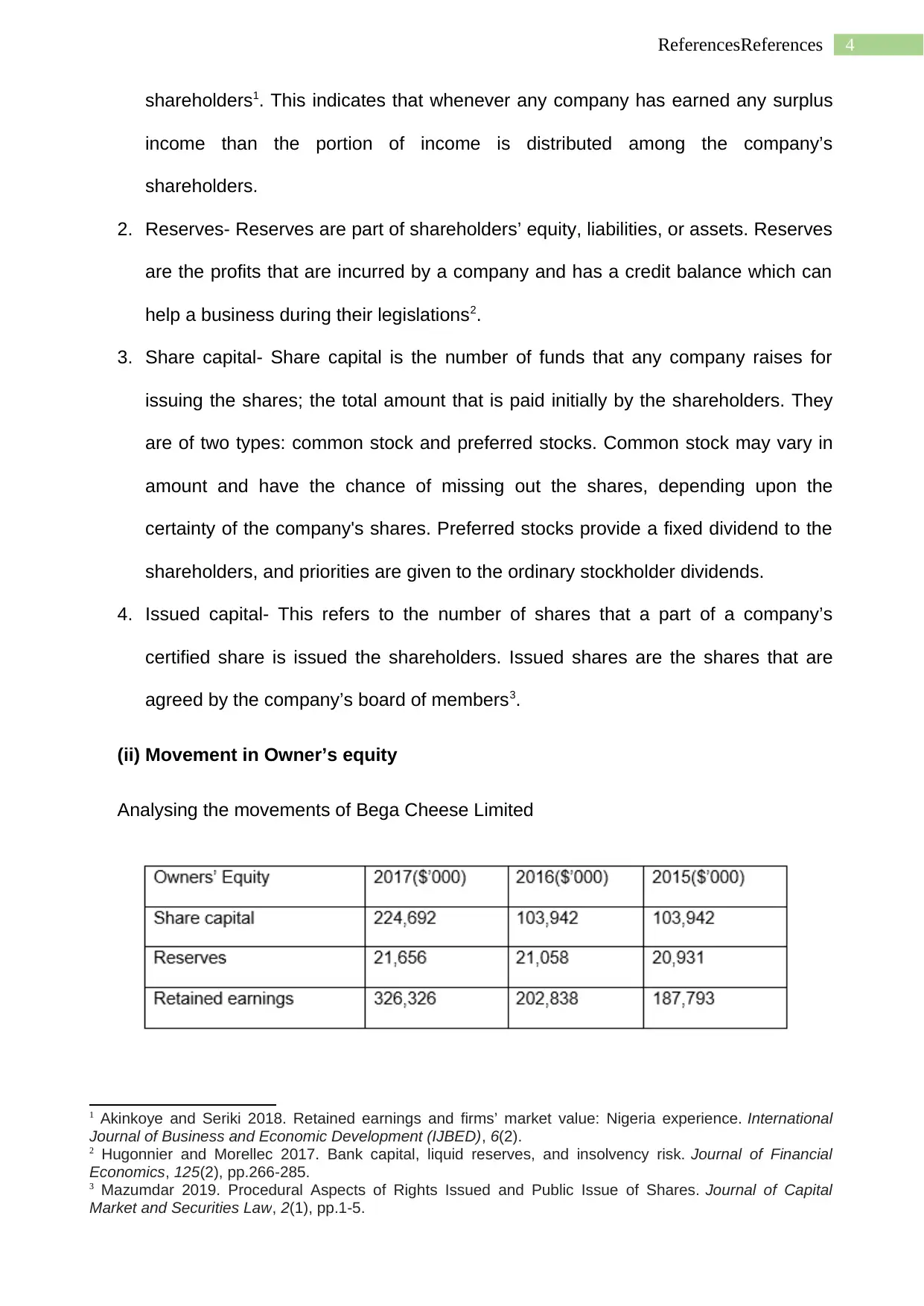
4ReferencesReferences
shareholders1. This indicates that whenever any company has earned any surplus
income than the portion of income is distributed among the company’s
shareholders.
2. Reserves- Reserves are part of shareholders’ equity, liabilities, or assets. Reserves
are the profits that are incurred by a company and has a credit balance which can
help a business during their legislations2.
3. Share capital- Share capital is the number of funds that any company raises for
issuing the shares; the total amount that is paid initially by the shareholders. They
are of two types: common stock and preferred stocks. Common stock may vary in
amount and have the chance of missing out the shares, depending upon the
certainty of the company's shares. Preferred stocks provide a fixed dividend to the
shareholders, and priorities are given to the ordinary stockholder dividends.
4. Issued capital- This refers to the number of shares that a part of a company’s
certified share is issued the shareholders. Issued shares are the shares that are
agreed by the company’s board of members3.
(ii) Movement in Owner’s equity
Analysing the movements of Bega Cheese Limited
1 Akinkoye and Seriki 2018. Retained earnings and firms’ market value: Nigeria experience. International
Journal of Business and Economic Development (IJBED), 6(2).
2 Hugonnier and Morellec 2017. Bank capital, liquid reserves, and insolvency risk. Journal of Financial
Economics, 125(2), pp.266-285.
3 Mazumdar 2019. Procedural Aspects of Rights Issued and Public Issue of Shares. Journal of Capital
Market and Securities Law, 2(1), pp.1-5.
shareholders1. This indicates that whenever any company has earned any surplus
income than the portion of income is distributed among the company’s
shareholders.
2. Reserves- Reserves are part of shareholders’ equity, liabilities, or assets. Reserves
are the profits that are incurred by a company and has a credit balance which can
help a business during their legislations2.
3. Share capital- Share capital is the number of funds that any company raises for
issuing the shares; the total amount that is paid initially by the shareholders. They
are of two types: common stock and preferred stocks. Common stock may vary in
amount and have the chance of missing out the shares, depending upon the
certainty of the company's shares. Preferred stocks provide a fixed dividend to the
shareholders, and priorities are given to the ordinary stockholder dividends.
4. Issued capital- This refers to the number of shares that a part of a company’s
certified share is issued the shareholders. Issued shares are the shares that are
agreed by the company’s board of members3.
(ii) Movement in Owner’s equity
Analysing the movements of Bega Cheese Limited
1 Akinkoye and Seriki 2018. Retained earnings and firms’ market value: Nigeria experience. International
Journal of Business and Economic Development (IJBED), 6(2).
2 Hugonnier and Morellec 2017. Bank capital, liquid reserves, and insolvency risk. Journal of Financial
Economics, 125(2), pp.266-285.
3 Mazumdar 2019. Procedural Aspects of Rights Issued and Public Issue of Shares. Journal of Capital
Market and Securities Law, 2(1), pp.1-5.
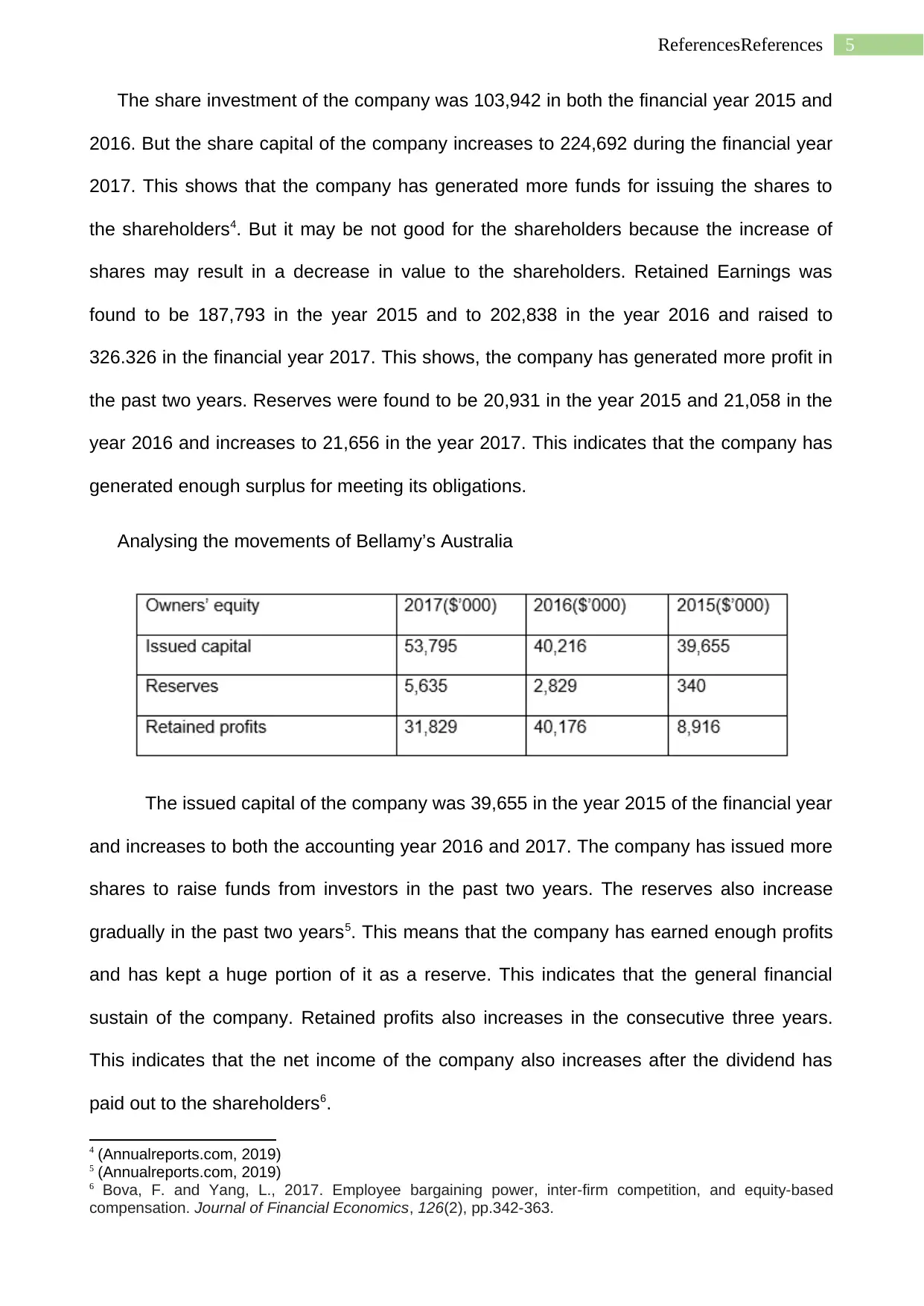
5ReferencesReferences
The share investment of the company was 103,942 in both the financial year 2015 and
2016. But the share capital of the company increases to 224,692 during the financial year
2017. This shows that the company has generated more funds for issuing the shares to
the shareholders4. But it may be not good for the shareholders because the increase of
shares may result in a decrease in value to the shareholders. Retained Earnings was
found to be 187,793 in the year 2015 and to 202,838 in the year 2016 and raised to
326.326 in the financial year 2017. This shows, the company has generated more profit in
the past two years. Reserves were found to be 20,931 in the year 2015 and 21,058 in the
year 2016 and increases to 21,656 in the year 2017. This indicates that the company has
generated enough surplus for meeting its obligations.
Analysing the movements of Bellamy’s Australia
The issued capital of the company was 39,655 in the year 2015 of the financial year
and increases to both the accounting year 2016 and 2017. The company has issued more
shares to raise funds from investors in the past two years. The reserves also increase
gradually in the past two years5. This means that the company has earned enough profits
and has kept a huge portion of it as a reserve. This indicates that the general financial
sustain of the company. Retained profits also increases in the consecutive three years.
This indicates that the net income of the company also increases after the dividend has
paid out to the shareholders6.
4 (Annualreports.com, 2019)
5 (Annualreports.com, 2019)
6 Bova, F. and Yang, L., 2017. Employee bargaining power, inter-firm competition, and equity-based
compensation. Journal of Financial Economics, 126(2), pp.342-363.
The share investment of the company was 103,942 in both the financial year 2015 and
2016. But the share capital of the company increases to 224,692 during the financial year
2017. This shows that the company has generated more funds for issuing the shares to
the shareholders4. But it may be not good for the shareholders because the increase of
shares may result in a decrease in value to the shareholders. Retained Earnings was
found to be 187,793 in the year 2015 and to 202,838 in the year 2016 and raised to
326.326 in the financial year 2017. This shows, the company has generated more profit in
the past two years. Reserves were found to be 20,931 in the year 2015 and 21,058 in the
year 2016 and increases to 21,656 in the year 2017. This indicates that the company has
generated enough surplus for meeting its obligations.
Analysing the movements of Bellamy’s Australia
The issued capital of the company was 39,655 in the year 2015 of the financial year
and increases to both the accounting year 2016 and 2017. The company has issued more
shares to raise funds from investors in the past two years. The reserves also increase
gradually in the past two years5. This means that the company has earned enough profits
and has kept a huge portion of it as a reserve. This indicates that the general financial
sustain of the company. Retained profits also increases in the consecutive three years.
This indicates that the net income of the company also increases after the dividend has
paid out to the shareholders6.
4 (Annualreports.com, 2019)
5 (Annualreports.com, 2019)
6 Bova, F. and Yang, L., 2017. Employee bargaining power, inter-firm competition, and equity-based
compensation. Journal of Financial Economics, 126(2), pp.342-363.
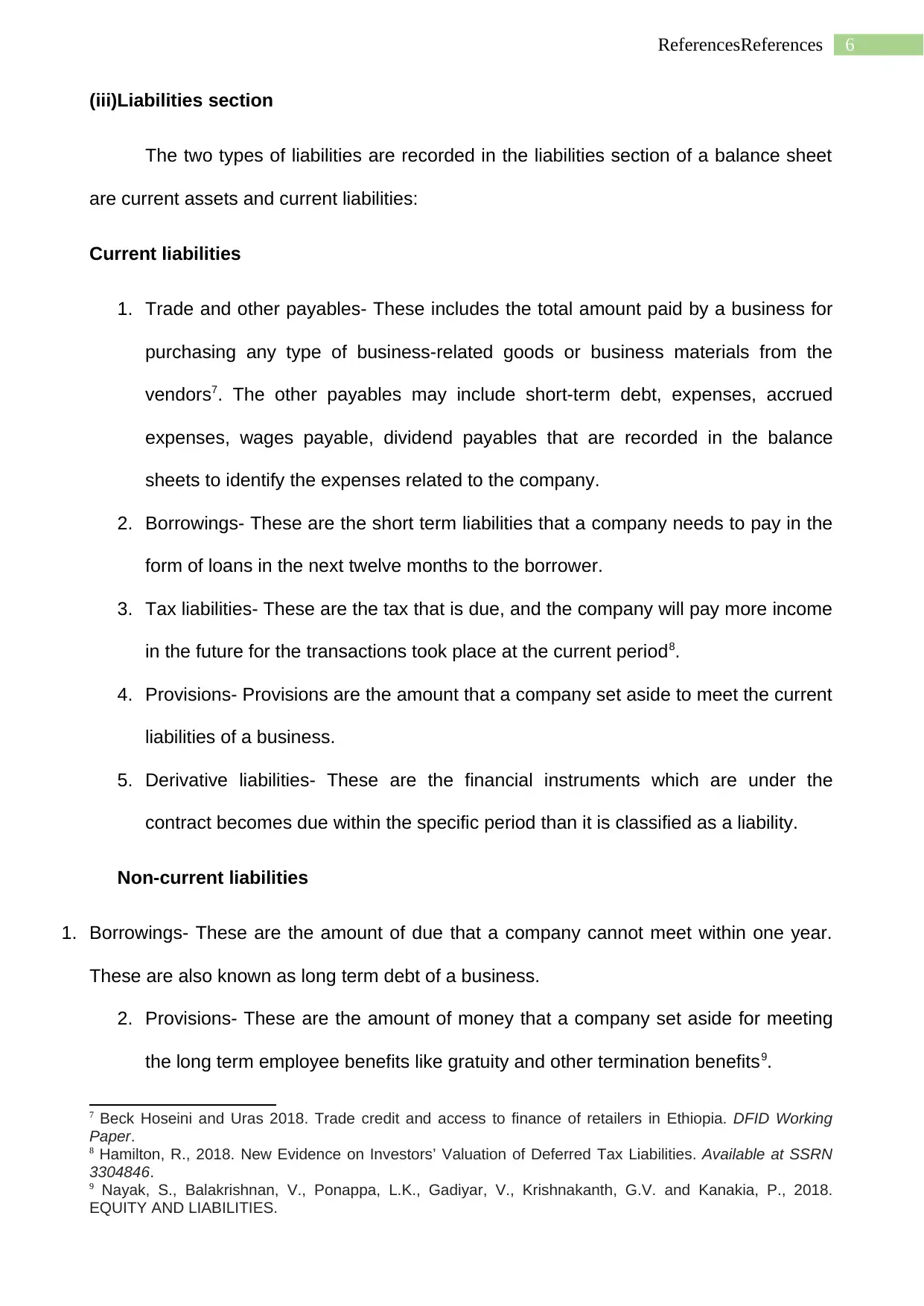
6ReferencesReferences
(iii)Liabilities section
The two types of liabilities are recorded in the liabilities section of a balance sheet
are current assets and current liabilities:
Current liabilities
1. Trade and other payables- These includes the total amount paid by a business for
purchasing any type of business-related goods or business materials from the
vendors7. The other payables may include short-term debt, expenses, accrued
expenses, wages payable, dividend payables that are recorded in the balance
sheets to identify the expenses related to the company.
2. Borrowings- These are the short term liabilities that a company needs to pay in the
form of loans in the next twelve months to the borrower.
3. Tax liabilities- These are the tax that is due, and the company will pay more income
in the future for the transactions took place at the current period8.
4. Provisions- Provisions are the amount that a company set aside to meet the current
liabilities of a business.
5. Derivative liabilities- These are the financial instruments which are under the
contract becomes due within the specific period than it is classified as a liability.
Non-current liabilities
1. Borrowings- These are the amount of due that a company cannot meet within one year.
These are also known as long term debt of a business.
2. Provisions- These are the amount of money that a company set aside for meeting
the long term employee benefits like gratuity and other termination benefits9.
7 Beck Hoseini and Uras 2018. Trade credit and access to finance of retailers in Ethiopia. DFID Working
Paper.
8 Hamilton, R., 2018. New Evidence on Investors’ Valuation of Deferred Tax Liabilities. Available at SSRN
3304846.
9 Nayak, S., Balakrishnan, V., Ponappa, L.K., Gadiyar, V., Krishnakanth, G.V. and Kanakia, P., 2018.
EQUITY AND LIABILITIES.
(iii)Liabilities section
The two types of liabilities are recorded in the liabilities section of a balance sheet
are current assets and current liabilities:
Current liabilities
1. Trade and other payables- These includes the total amount paid by a business for
purchasing any type of business-related goods or business materials from the
vendors7. The other payables may include short-term debt, expenses, accrued
expenses, wages payable, dividend payables that are recorded in the balance
sheets to identify the expenses related to the company.
2. Borrowings- These are the short term liabilities that a company needs to pay in the
form of loans in the next twelve months to the borrower.
3. Tax liabilities- These are the tax that is due, and the company will pay more income
in the future for the transactions took place at the current period8.
4. Provisions- Provisions are the amount that a company set aside to meet the current
liabilities of a business.
5. Derivative liabilities- These are the financial instruments which are under the
contract becomes due within the specific period than it is classified as a liability.
Non-current liabilities
1. Borrowings- These are the amount of due that a company cannot meet within one year.
These are also known as long term debt of a business.
2. Provisions- These are the amount of money that a company set aside for meeting
the long term employee benefits like gratuity and other termination benefits9.
7 Beck Hoseini and Uras 2018. Trade credit and access to finance of retailers in Ethiopia. DFID Working
Paper.
8 Hamilton, R., 2018. New Evidence on Investors’ Valuation of Deferred Tax Liabilities. Available at SSRN
3304846.
9 Nayak, S., Balakrishnan, V., Ponappa, L.K., Gadiyar, V., Krishnakanth, G.V. and Kanakia, P., 2018.
EQUITY AND LIABILITIES.
Paraphrase This Document
Need a fresh take? Get an instant paraphrase of this document with our AI Paraphraser
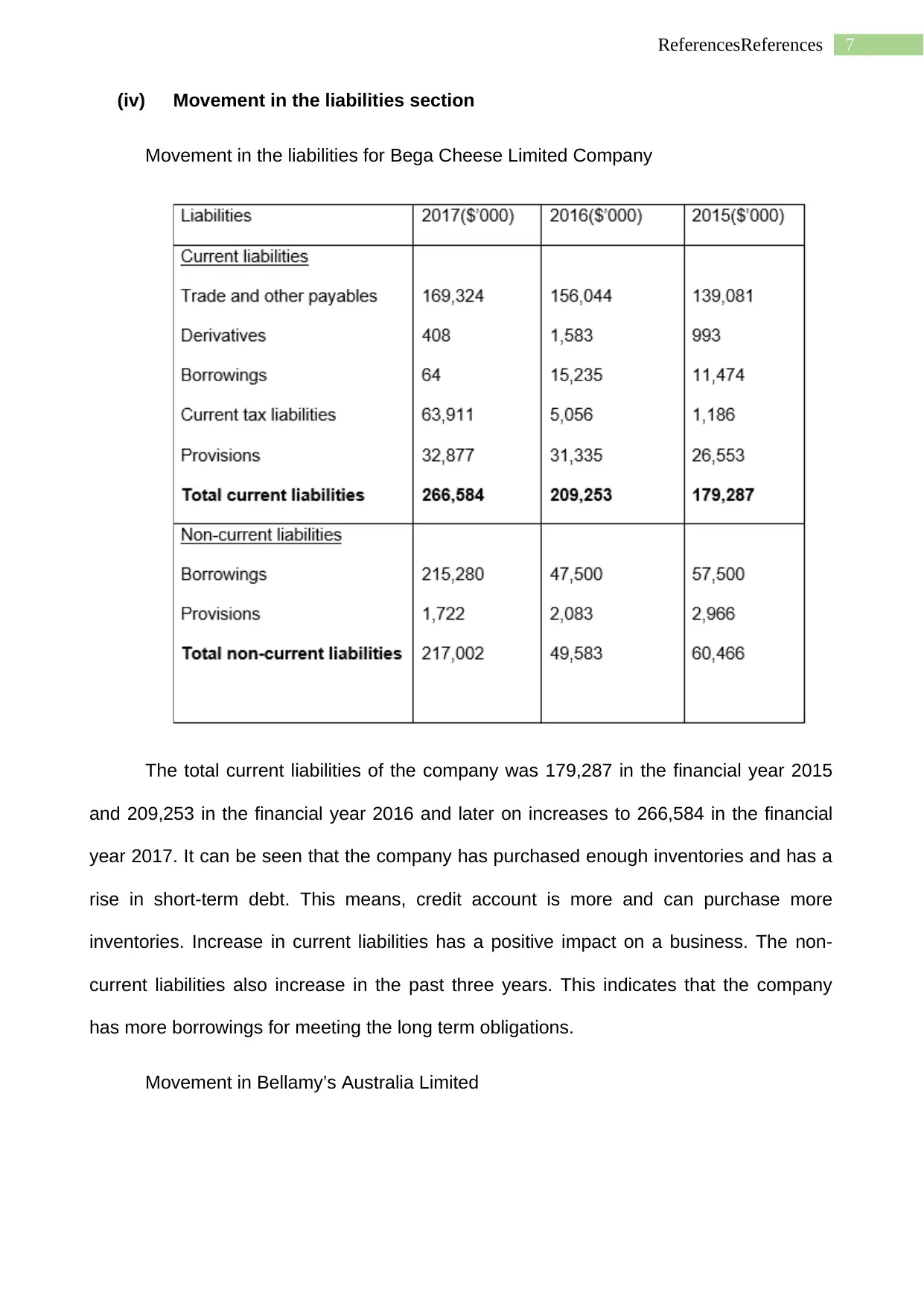
7ReferencesReferences
(iv) Movement in the liabilities section
Movement in the liabilities for Bega Cheese Limited Company
The total current liabilities of the company was 179,287 in the financial year 2015
and 209,253 in the financial year 2016 and later on increases to 266,584 in the financial
year 2017. It can be seen that the company has purchased enough inventories and has a
rise in short-term debt. This means, credit account is more and can purchase more
inventories. Increase in current liabilities has a positive impact on a business. The non-
current liabilities also increase in the past three years. This indicates that the company
has more borrowings for meeting the long term obligations.
Movement in Bellamy’s Australia Limited
(iv) Movement in the liabilities section
Movement in the liabilities for Bega Cheese Limited Company
The total current liabilities of the company was 179,287 in the financial year 2015
and 209,253 in the financial year 2016 and later on increases to 266,584 in the financial
year 2017. It can be seen that the company has purchased enough inventories and has a
rise in short-term debt. This means, credit account is more and can purchase more
inventories. Increase in current liabilities has a positive impact on a business. The non-
current liabilities also increase in the past three years. This indicates that the company
has more borrowings for meeting the long term obligations.
Movement in Bellamy’s Australia Limited
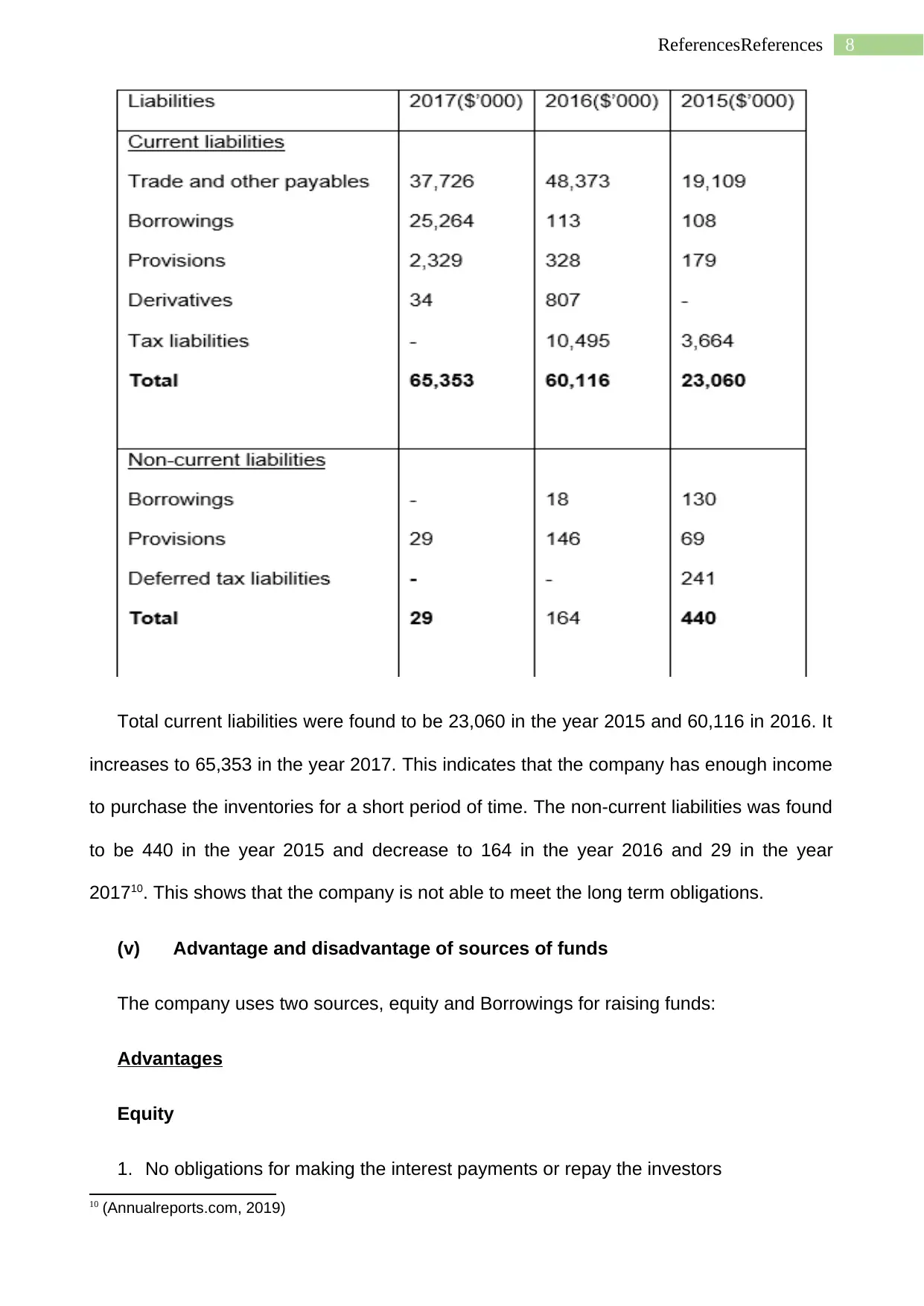
8ReferencesReferences
Total current liabilities were found to be 23,060 in the year 2015 and 60,116 in 2016. It
increases to 65,353 in the year 2017. This indicates that the company has enough income
to purchase the inventories for a short period of time. The non-current liabilities was found
to be 440 in the year 2015 and decrease to 164 in the year 2016 and 29 in the year
201710. This shows that the company is not able to meet the long term obligations.
(v) Advantage and disadvantage of sources of funds
The company uses two sources, equity and Borrowings for raising funds:
Advantages
Equity
1. No obligations for making the interest payments or repay the investors
10 (Annualreports.com, 2019)
Total current liabilities were found to be 23,060 in the year 2015 and 60,116 in 2016. It
increases to 65,353 in the year 2017. This indicates that the company has enough income
to purchase the inventories for a short period of time. The non-current liabilities was found
to be 440 in the year 2015 and decrease to 164 in the year 2016 and 29 in the year
201710. This shows that the company is not able to meet the long term obligations.
(v) Advantage and disadvantage of sources of funds
The company uses two sources, equity and Borrowings for raising funds:
Advantages
Equity
1. No obligations for making the interest payments or repay the investors
10 (Annualreports.com, 2019)
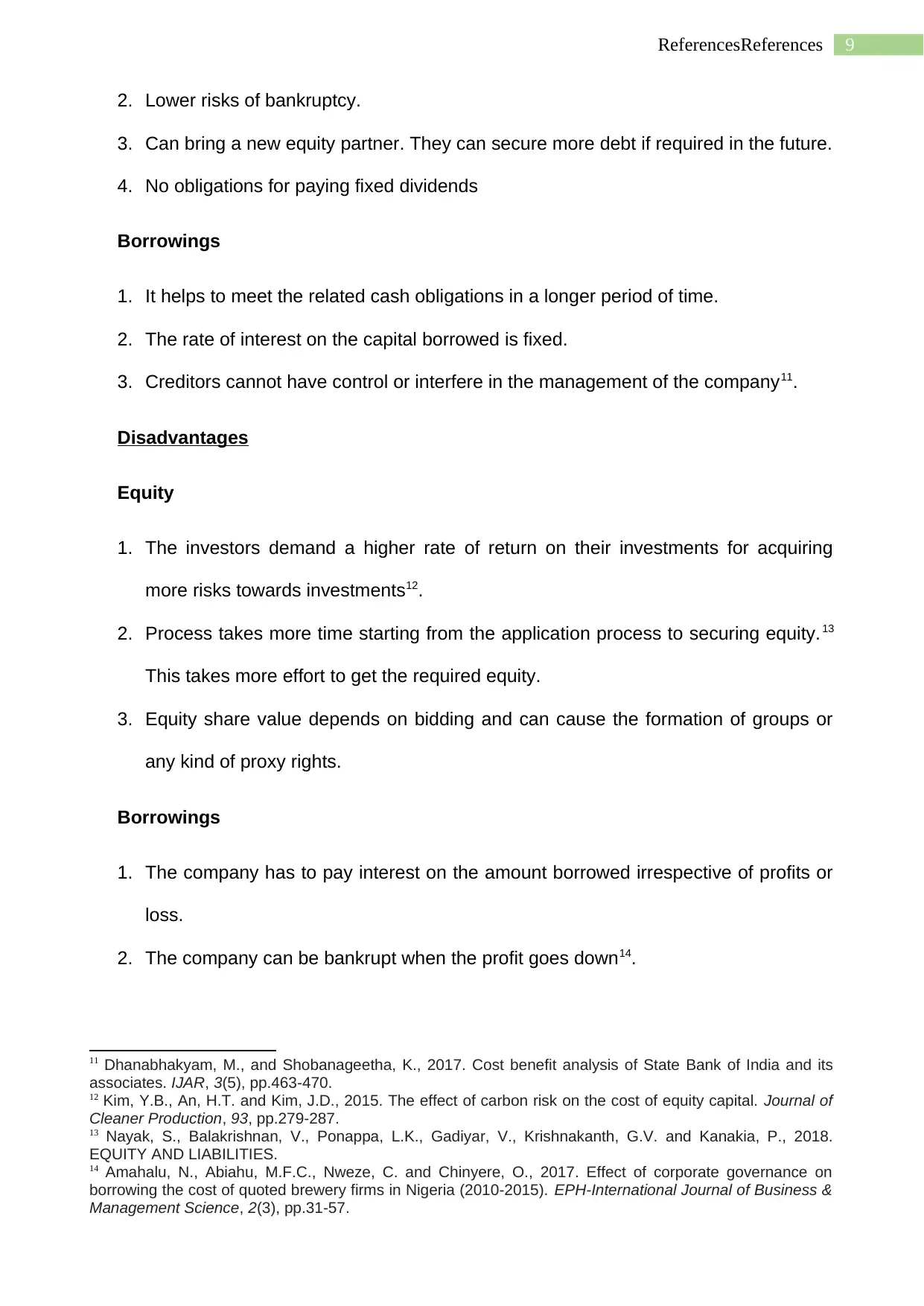
9ReferencesReferences
2. Lower risks of bankruptcy.
3. Can bring a new equity partner. They can secure more debt if required in the future.
4. No obligations for paying fixed dividends
Borrowings
1. It helps to meet the related cash obligations in a longer period of time.
2. The rate of interest on the capital borrowed is fixed.
3. Creditors cannot have control or interfere in the management of the company11.
Disadvantages
Equity
1. The investors demand a higher rate of return on their investments for acquiring
more risks towards investments12.
2. Process takes more time starting from the application process to securing equity.13
This takes more effort to get the required equity.
3. Equity share value depends on bidding and can cause the formation of groups or
any kind of proxy rights.
Borrowings
1. The company has to pay interest on the amount borrowed irrespective of profits or
loss.
2. The company can be bankrupt when the profit goes down14.
11 Dhanabhakyam, M., and Shobanageetha, K., 2017. Cost benefit analysis of State Bank of India and its
associates. IJAR, 3(5), pp.463-470.
12 Kim, Y.B., An, H.T. and Kim, J.D., 2015. The effect of carbon risk on the cost of equity capital. Journal of
Cleaner Production, 93, pp.279-287.
13 Nayak, S., Balakrishnan, V., Ponappa, L.K., Gadiyar, V., Krishnakanth, G.V. and Kanakia, P., 2018.
EQUITY AND LIABILITIES.
14 Amahalu, N., Abiahu, M.F.C., Nweze, C. and Chinyere, O., 2017. Effect of corporate governance on
borrowing the cost of quoted brewery firms in Nigeria (2010-2015). EPH-International Journal of Business &
Management Science, 2(3), pp.31-57.
2. Lower risks of bankruptcy.
3. Can bring a new equity partner. They can secure more debt if required in the future.
4. No obligations for paying fixed dividends
Borrowings
1. It helps to meet the related cash obligations in a longer period of time.
2. The rate of interest on the capital borrowed is fixed.
3. Creditors cannot have control or interfere in the management of the company11.
Disadvantages
Equity
1. The investors demand a higher rate of return on their investments for acquiring
more risks towards investments12.
2. Process takes more time starting from the application process to securing equity.13
This takes more effort to get the required equity.
3. Equity share value depends on bidding and can cause the formation of groups or
any kind of proxy rights.
Borrowings
1. The company has to pay interest on the amount borrowed irrespective of profits or
loss.
2. The company can be bankrupt when the profit goes down14.
11 Dhanabhakyam, M., and Shobanageetha, K., 2017. Cost benefit analysis of State Bank of India and its
associates. IJAR, 3(5), pp.463-470.
12 Kim, Y.B., An, H.T. and Kim, J.D., 2015. The effect of carbon risk on the cost of equity capital. Journal of
Cleaner Production, 93, pp.279-287.
13 Nayak, S., Balakrishnan, V., Ponappa, L.K., Gadiyar, V., Krishnakanth, G.V. and Kanakia, P., 2018.
EQUITY AND LIABILITIES.
14 Amahalu, N., Abiahu, M.F.C., Nweze, C. and Chinyere, O., 2017. Effect of corporate governance on
borrowing the cost of quoted brewery firms in Nigeria (2010-2015). EPH-International Journal of Business &
Management Science, 2(3), pp.31-57.
Secure Best Marks with AI Grader
Need help grading? Try our AI Grader for instant feedback on your assignments.
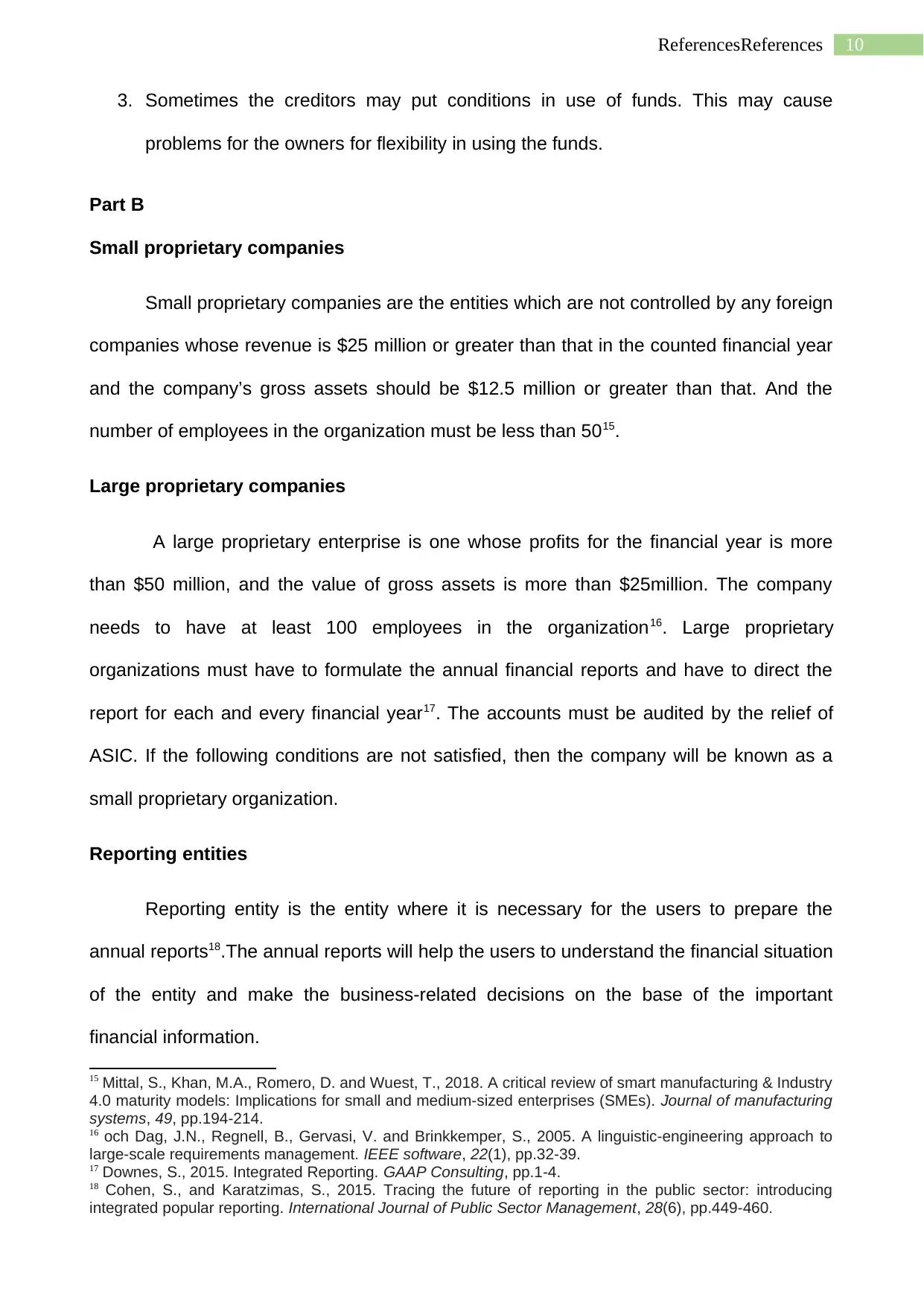
10ReferencesReferences
3. Sometimes the creditors may put conditions in use of funds. This may cause
problems for the owners for flexibility in using the funds.
Part B
Small proprietary companies
Small proprietary companies are the entities which are not controlled by any foreign
companies whose revenue is $25 million or greater than that in the counted financial year
and the company’s gross assets should be $12.5 million or greater than that. And the
number of employees in the organization must be less than 5015.
Large proprietary companies
A large proprietary enterprise is one whose profits for the financial year is more
than $50 million, and the value of gross assets is more than $25million. The company
needs to have at least 100 employees in the organization16. Large proprietary
organizations must have to formulate the annual financial reports and have to direct the
report for each and every financial year17. The accounts must be audited by the relief of
ASIC. If the following conditions are not satisfied, then the company will be known as a
small proprietary organization.
Reporting entities
Reporting entity is the entity where it is necessary for the users to prepare the
annual reports18.The annual reports will help the users to understand the financial situation
of the entity and make the business-related decisions on the base of the important
financial information.
15 Mittal, S., Khan, M.A., Romero, D. and Wuest, T., 2018. A critical review of smart manufacturing & Industry
4.0 maturity models: Implications for small and medium-sized enterprises (SMEs). Journal of manufacturing
systems, 49, pp.194-214.
16 och Dag, J.N., Regnell, B., Gervasi, V. and Brinkkemper, S., 2005. A linguistic-engineering approach to
large-scale requirements management. IEEE software, 22(1), pp.32-39.
17 Downes, S., 2015. Integrated Reporting. GAAP Consulting, pp.1-4.
18 Cohen, S., and Karatzimas, S., 2015. Tracing the future of reporting in the public sector: introducing
integrated popular reporting. International Journal of Public Sector Management, 28(6), pp.449-460.
3. Sometimes the creditors may put conditions in use of funds. This may cause
problems for the owners for flexibility in using the funds.
Part B
Small proprietary companies
Small proprietary companies are the entities which are not controlled by any foreign
companies whose revenue is $25 million or greater than that in the counted financial year
and the company’s gross assets should be $12.5 million or greater than that. And the
number of employees in the organization must be less than 5015.
Large proprietary companies
A large proprietary enterprise is one whose profits for the financial year is more
than $50 million, and the value of gross assets is more than $25million. The company
needs to have at least 100 employees in the organization16. Large proprietary
organizations must have to formulate the annual financial reports and have to direct the
report for each and every financial year17. The accounts must be audited by the relief of
ASIC. If the following conditions are not satisfied, then the company will be known as a
small proprietary organization.
Reporting entities
Reporting entity is the entity where it is necessary for the users to prepare the
annual reports18.The annual reports will help the users to understand the financial situation
of the entity and make the business-related decisions on the base of the important
financial information.
15 Mittal, S., Khan, M.A., Romero, D. and Wuest, T., 2018. A critical review of smart manufacturing & Industry
4.0 maturity models: Implications for small and medium-sized enterprises (SMEs). Journal of manufacturing
systems, 49, pp.194-214.
16 och Dag, J.N., Regnell, B., Gervasi, V. and Brinkkemper, S., 2005. A linguistic-engineering approach to
large-scale requirements management. IEEE software, 22(1), pp.32-39.
17 Downes, S., 2015. Integrated Reporting. GAAP Consulting, pp.1-4.
18 Cohen, S., and Karatzimas, S., 2015. Tracing the future of reporting in the public sector: introducing
integrated popular reporting. International Journal of Public Sector Management, 28(6), pp.449-460.
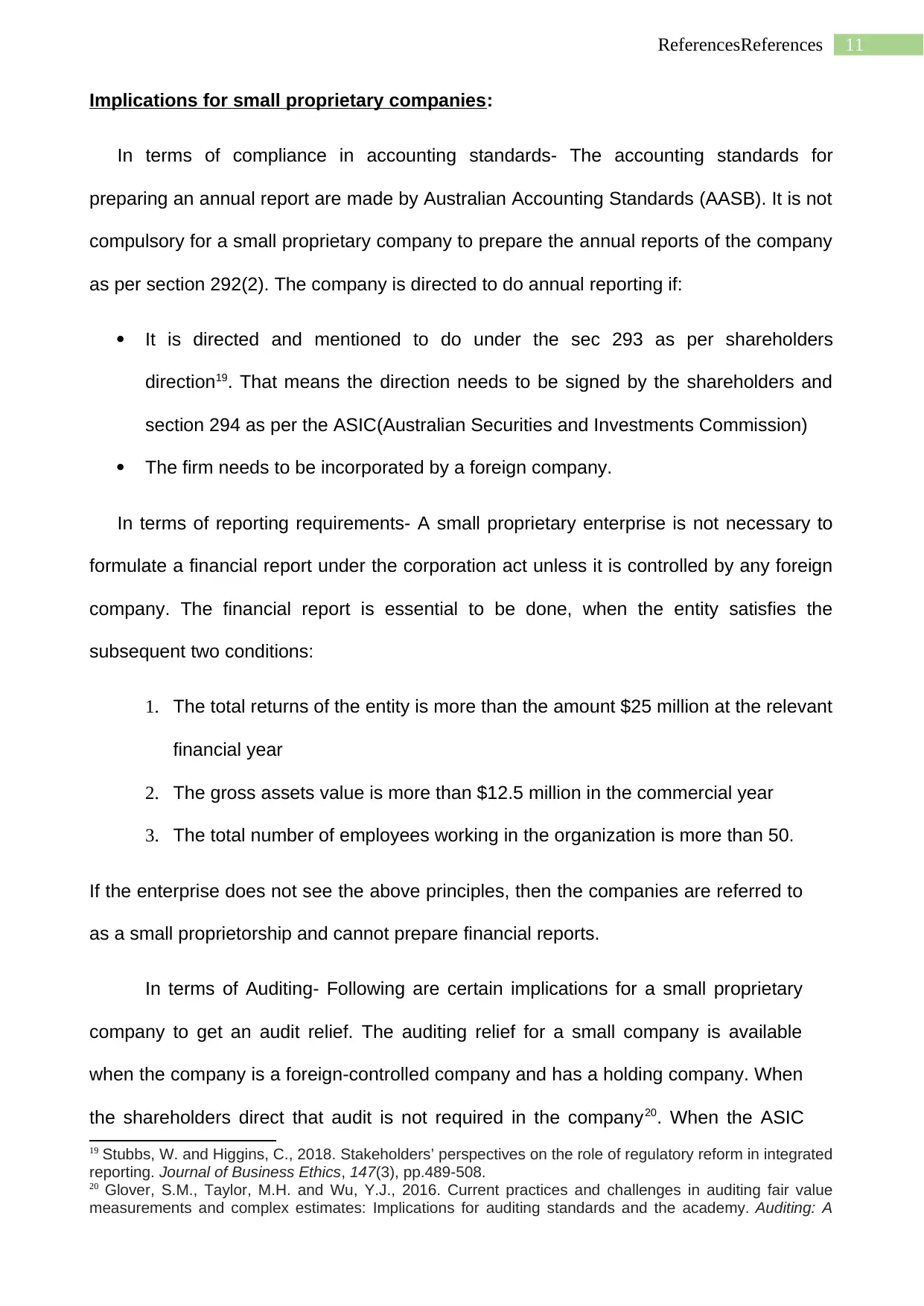
11ReferencesReferences
Implications for small proprietary companies:
In terms of compliance in accounting standards- The accounting standards for
preparing an annual report are made by Australian Accounting Standards (AASB). It is not
compulsory for a small proprietary company to prepare the annual reports of the company
as per section 292(2). The company is directed to do annual reporting if:
It is directed and mentioned to do under the sec 293 as per shareholders
direction19. That means the direction needs to be signed by the shareholders and
section 294 as per the ASIC(Australian Securities and Investments Commission)
The firm needs to be incorporated by a foreign company.
In terms of reporting requirements- A small proprietary enterprise is not necessary to
formulate a financial report under the corporation act unless it is controlled by any foreign
company. The financial report is essential to be done, when the entity satisfies the
subsequent two conditions:
1. The total returns of the entity is more than the amount $25 million at the relevant
financial year
2. The gross assets value is more than $12.5 million in the commercial year
3. The total number of employees working in the organization is more than 50.
If the enterprise does not see the above principles, then the companies are referred to
as a small proprietorship and cannot prepare financial reports.
In terms of Auditing- Following are certain implications for a small proprietary
company to get an audit relief. The auditing relief for a small company is available
when the company is a foreign-controlled company and has a holding company. When
the shareholders direct that audit is not required in the company20. When the ASIC
19 Stubbs, W. and Higgins, C., 2018. Stakeholders’ perspectives on the role of regulatory reform in integrated
reporting. Journal of Business Ethics, 147(3), pp.489-508.
20 Glover, S.M., Taylor, M.H. and Wu, Y.J., 2016. Current practices and challenges in auditing fair value
measurements and complex estimates: Implications for auditing standards and the academy. Auditing: A
Implications for small proprietary companies:
In terms of compliance in accounting standards- The accounting standards for
preparing an annual report are made by Australian Accounting Standards (AASB). It is not
compulsory for a small proprietary company to prepare the annual reports of the company
as per section 292(2). The company is directed to do annual reporting if:
It is directed and mentioned to do under the sec 293 as per shareholders
direction19. That means the direction needs to be signed by the shareholders and
section 294 as per the ASIC(Australian Securities and Investments Commission)
The firm needs to be incorporated by a foreign company.
In terms of reporting requirements- A small proprietary enterprise is not necessary to
formulate a financial report under the corporation act unless it is controlled by any foreign
company. The financial report is essential to be done, when the entity satisfies the
subsequent two conditions:
1. The total returns of the entity is more than the amount $25 million at the relevant
financial year
2. The gross assets value is more than $12.5 million in the commercial year
3. The total number of employees working in the organization is more than 50.
If the enterprise does not see the above principles, then the companies are referred to
as a small proprietorship and cannot prepare financial reports.
In terms of Auditing- Following are certain implications for a small proprietary
company to get an audit relief. The auditing relief for a small company is available
when the company is a foreign-controlled company and has a holding company. When
the shareholders direct that audit is not required in the company20. When the ASIC
19 Stubbs, W. and Higgins, C., 2018. Stakeholders’ perspectives on the role of regulatory reform in integrated
reporting. Journal of Business Ethics, 147(3), pp.489-508.
20 Glover, S.M., Taylor, M.H. and Wu, Y.J., 2016. Current practices and challenges in auditing fair value
measurements and complex estimates: Implications for auditing standards and the academy. Auditing: A
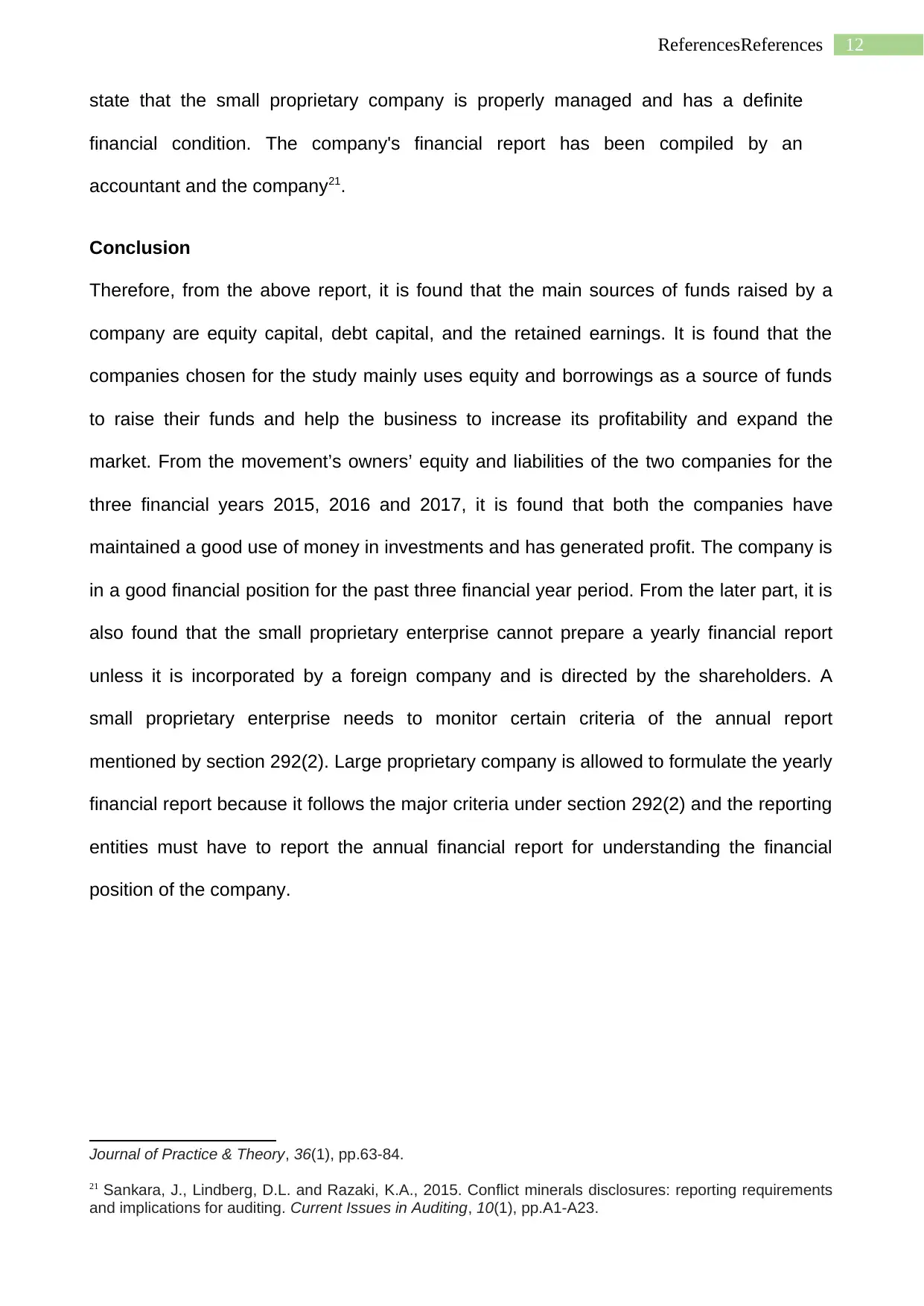
12ReferencesReferences
state that the small proprietary company is properly managed and has a definite
financial condition. The company's financial report has been compiled by an
accountant and the company21.
Conclusion
Therefore, from the above report, it is found that the main sources of funds raised by a
company are equity capital, debt capital, and the retained earnings. It is found that the
companies chosen for the study mainly uses equity and borrowings as a source of funds
to raise their funds and help the business to increase its profitability and expand the
market. From the movement’s owners’ equity and liabilities of the two companies for the
three financial years 2015, 2016 and 2017, it is found that both the companies have
maintained a good use of money in investments and has generated profit. The company is
in a good financial position for the past three financial year period. From the later part, it is
also found that the small proprietary enterprise cannot prepare a yearly financial report
unless it is incorporated by a foreign company and is directed by the shareholders. A
small proprietary enterprise needs to monitor certain criteria of the annual report
mentioned by section 292(2). Large proprietary company is allowed to formulate the yearly
financial report because it follows the major criteria under section 292(2) and the reporting
entities must have to report the annual financial report for understanding the financial
position of the company.
Journal of Practice & Theory, 36(1), pp.63-84.
21 Sankara, J., Lindberg, D.L. and Razaki, K.A., 2015. Conflict minerals disclosures: reporting requirements
and implications for auditing. Current Issues in Auditing, 10(1), pp.A1-A23.
state that the small proprietary company is properly managed and has a definite
financial condition. The company's financial report has been compiled by an
accountant and the company21.
Conclusion
Therefore, from the above report, it is found that the main sources of funds raised by a
company are equity capital, debt capital, and the retained earnings. It is found that the
companies chosen for the study mainly uses equity and borrowings as a source of funds
to raise their funds and help the business to increase its profitability and expand the
market. From the movement’s owners’ equity and liabilities of the two companies for the
three financial years 2015, 2016 and 2017, it is found that both the companies have
maintained a good use of money in investments and has generated profit. The company is
in a good financial position for the past three financial year period. From the later part, it is
also found that the small proprietary enterprise cannot prepare a yearly financial report
unless it is incorporated by a foreign company and is directed by the shareholders. A
small proprietary enterprise needs to monitor certain criteria of the annual report
mentioned by section 292(2). Large proprietary company is allowed to formulate the yearly
financial report because it follows the major criteria under section 292(2) and the reporting
entities must have to report the annual financial report for understanding the financial
position of the company.
Journal of Practice & Theory, 36(1), pp.63-84.
21 Sankara, J., Lindberg, D.L. and Razaki, K.A., 2015. Conflict minerals disclosures: reporting requirements
and implications for auditing. Current Issues in Auditing, 10(1), pp.A1-A23.
Paraphrase This Document
Need a fresh take? Get an instant paraphrase of this document with our AI Paraphraser
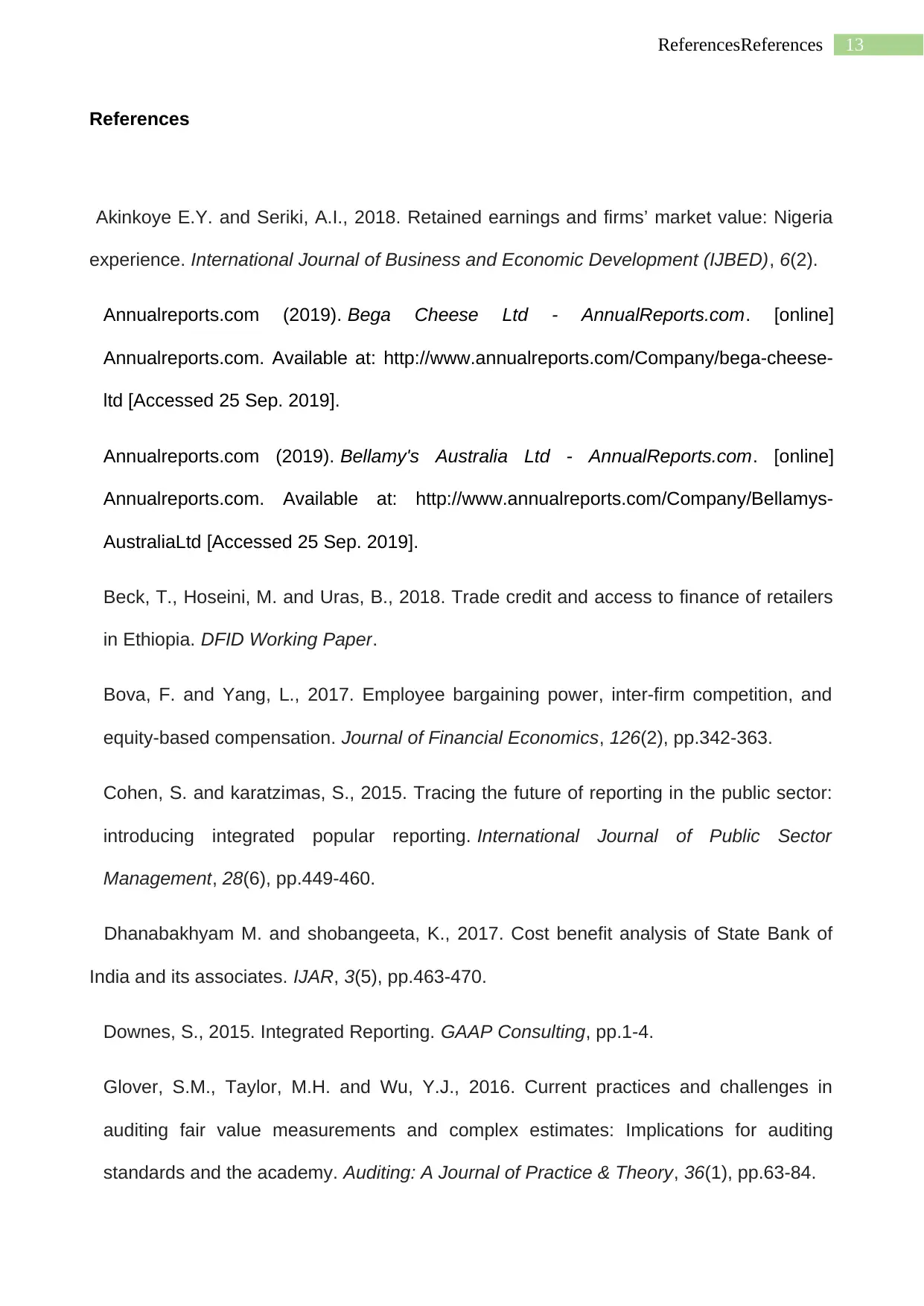
13ReferencesReferences
References
Akinkoye E.Y. and Seriki, A.I., 2018. Retained earnings and firms’ market value: Nigeria
experience. International Journal of Business and Economic Development (IJBED), 6(2).
Annualreports.com (2019). Bega Cheese Ltd - AnnualReports.com. [online]
Annualreports.com. Available at: http://www.annualreports.com/Company/bega-cheese-
ltd [Accessed 25 Sep. 2019].
Annualreports.com (2019). Bellamy's Australia Ltd - AnnualReports.com. [online]
Annualreports.com. Available at: http://www.annualreports.com/Company/Bellamys-
AustraliaLtd [Accessed 25 Sep. 2019].
Beck, T., Hoseini, M. and Uras, B., 2018. Trade credit and access to finance of retailers
in Ethiopia. DFID Working Paper.
Bova, F. and Yang, L., 2017. Employee bargaining power, inter-firm competition, and
equity-based compensation. Journal of Financial Economics, 126(2), pp.342-363.
Cohen, S. and karatzimas, S., 2015. Tracing the future of reporting in the public sector:
introducing integrated popular reporting. International Journal of Public Sector
Management, 28(6), pp.449-460.
Dhanabakhyam M. and shobangeeta, K., 2017. Cost benefit analysis of State Bank of
India and its associates. IJAR, 3(5), pp.463-470.
Downes, S., 2015. Integrated Reporting. GAAP Consulting, pp.1-4.
Glover, S.M., Taylor, M.H. and Wu, Y.J., 2016. Current practices and challenges in
auditing fair value measurements and complex estimates: Implications for auditing
standards and the academy. Auditing: A Journal of Practice & Theory, 36(1), pp.63-84.
References
Akinkoye E.Y. and Seriki, A.I., 2018. Retained earnings and firms’ market value: Nigeria
experience. International Journal of Business and Economic Development (IJBED), 6(2).
Annualreports.com (2019). Bega Cheese Ltd - AnnualReports.com. [online]
Annualreports.com. Available at: http://www.annualreports.com/Company/bega-cheese-
ltd [Accessed 25 Sep. 2019].
Annualreports.com (2019). Bellamy's Australia Ltd - AnnualReports.com. [online]
Annualreports.com. Available at: http://www.annualreports.com/Company/Bellamys-
AustraliaLtd [Accessed 25 Sep. 2019].
Beck, T., Hoseini, M. and Uras, B., 2018. Trade credit and access to finance of retailers
in Ethiopia. DFID Working Paper.
Bova, F. and Yang, L., 2017. Employee bargaining power, inter-firm competition, and
equity-based compensation. Journal of Financial Economics, 126(2), pp.342-363.
Cohen, S. and karatzimas, S., 2015. Tracing the future of reporting in the public sector:
introducing integrated popular reporting. International Journal of Public Sector
Management, 28(6), pp.449-460.
Dhanabakhyam M. and shobangeeta, K., 2017. Cost benefit analysis of State Bank of
India and its associates. IJAR, 3(5), pp.463-470.
Downes, S., 2015. Integrated Reporting. GAAP Consulting, pp.1-4.
Glover, S.M., Taylor, M.H. and Wu, Y.J., 2016. Current practices and challenges in
auditing fair value measurements and complex estimates: Implications for auditing
standards and the academy. Auditing: A Journal of Practice & Theory, 36(1), pp.63-84.
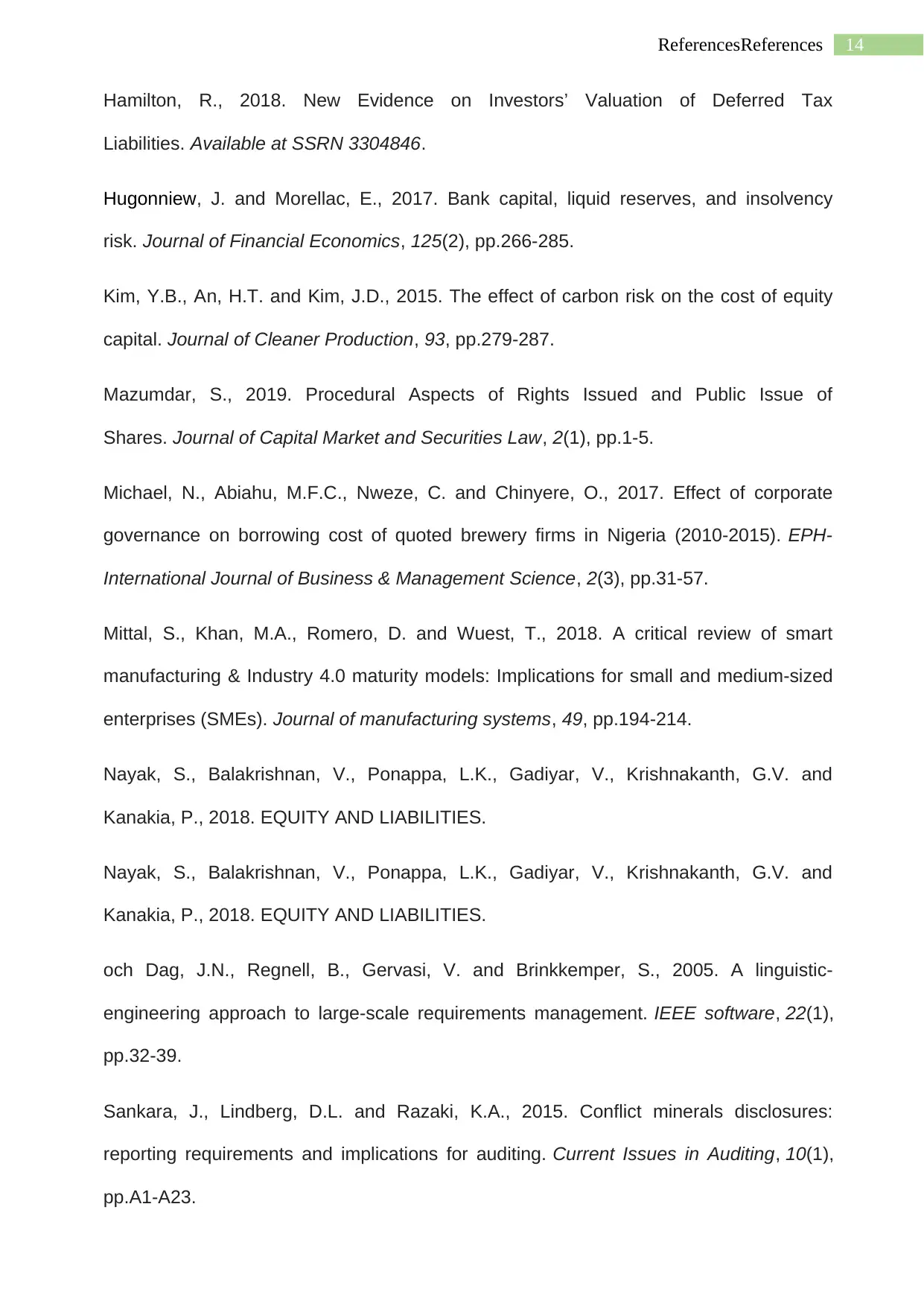
14ReferencesReferences
Hamilton, R., 2018. New Evidence on Investors’ Valuation of Deferred Tax
Liabilities. Available at SSRN 3304846.
Hugonniew, J. and Morellac, E., 2017. Bank capital, liquid reserves, and insolvency
risk. Journal of Financial Economics, 125(2), pp.266-285.
Kim, Y.B., An, H.T. and Kim, J.D., 2015. The effect of carbon risk on the cost of equity
capital. Journal of Cleaner Production, 93, pp.279-287.
Mazumdar, S., 2019. Procedural Aspects of Rights Issued and Public Issue of
Shares. Journal of Capital Market and Securities Law, 2(1), pp.1-5.
Michael, N., Abiahu, M.F.C., Nweze, C. and Chinyere, O., 2017. Effect of corporate
governance on borrowing cost of quoted brewery firms in Nigeria (2010-2015). EPH-
International Journal of Business & Management Science, 2(3), pp.31-57.
Mittal, S., Khan, M.A., Romero, D. and Wuest, T., 2018. A critical review of smart
manufacturing & Industry 4.0 maturity models: Implications for small and medium-sized
enterprises (SMEs). Journal of manufacturing systems, 49, pp.194-214.
Nayak, S., Balakrishnan, V., Ponappa, L.K., Gadiyar, V., Krishnakanth, G.V. and
Kanakia, P., 2018. EQUITY AND LIABILITIES.
Nayak, S., Balakrishnan, V., Ponappa, L.K., Gadiyar, V., Krishnakanth, G.V. and
Kanakia, P., 2018. EQUITY AND LIABILITIES.
och Dag, J.N., Regnell, B., Gervasi, V. and Brinkkemper, S., 2005. A linguistic-
engineering approach to large-scale requirements management. IEEE software, 22(1),
pp.32-39.
Sankara, J., Lindberg, D.L. and Razaki, K.A., 2015. Conflict minerals disclosures:
reporting requirements and implications for auditing. Current Issues in Auditing, 10(1),
pp.A1-A23.
Hamilton, R., 2018. New Evidence on Investors’ Valuation of Deferred Tax
Liabilities. Available at SSRN 3304846.
Hugonniew, J. and Morellac, E., 2017. Bank capital, liquid reserves, and insolvency
risk. Journal of Financial Economics, 125(2), pp.266-285.
Kim, Y.B., An, H.T. and Kim, J.D., 2015. The effect of carbon risk on the cost of equity
capital. Journal of Cleaner Production, 93, pp.279-287.
Mazumdar, S., 2019. Procedural Aspects of Rights Issued and Public Issue of
Shares. Journal of Capital Market and Securities Law, 2(1), pp.1-5.
Michael, N., Abiahu, M.F.C., Nweze, C. and Chinyere, O., 2017. Effect of corporate
governance on borrowing cost of quoted brewery firms in Nigeria (2010-2015). EPH-
International Journal of Business & Management Science, 2(3), pp.31-57.
Mittal, S., Khan, M.A., Romero, D. and Wuest, T., 2018. A critical review of smart
manufacturing & Industry 4.0 maturity models: Implications for small and medium-sized
enterprises (SMEs). Journal of manufacturing systems, 49, pp.194-214.
Nayak, S., Balakrishnan, V., Ponappa, L.K., Gadiyar, V., Krishnakanth, G.V. and
Kanakia, P., 2018. EQUITY AND LIABILITIES.
Nayak, S., Balakrishnan, V., Ponappa, L.K., Gadiyar, V., Krishnakanth, G.V. and
Kanakia, P., 2018. EQUITY AND LIABILITIES.
och Dag, J.N., Regnell, B., Gervasi, V. and Brinkkemper, S., 2005. A linguistic-
engineering approach to large-scale requirements management. IEEE software, 22(1),
pp.32-39.
Sankara, J., Lindberg, D.L. and Razaki, K.A., 2015. Conflict minerals disclosures:
reporting requirements and implications for auditing. Current Issues in Auditing, 10(1),
pp.A1-A23.
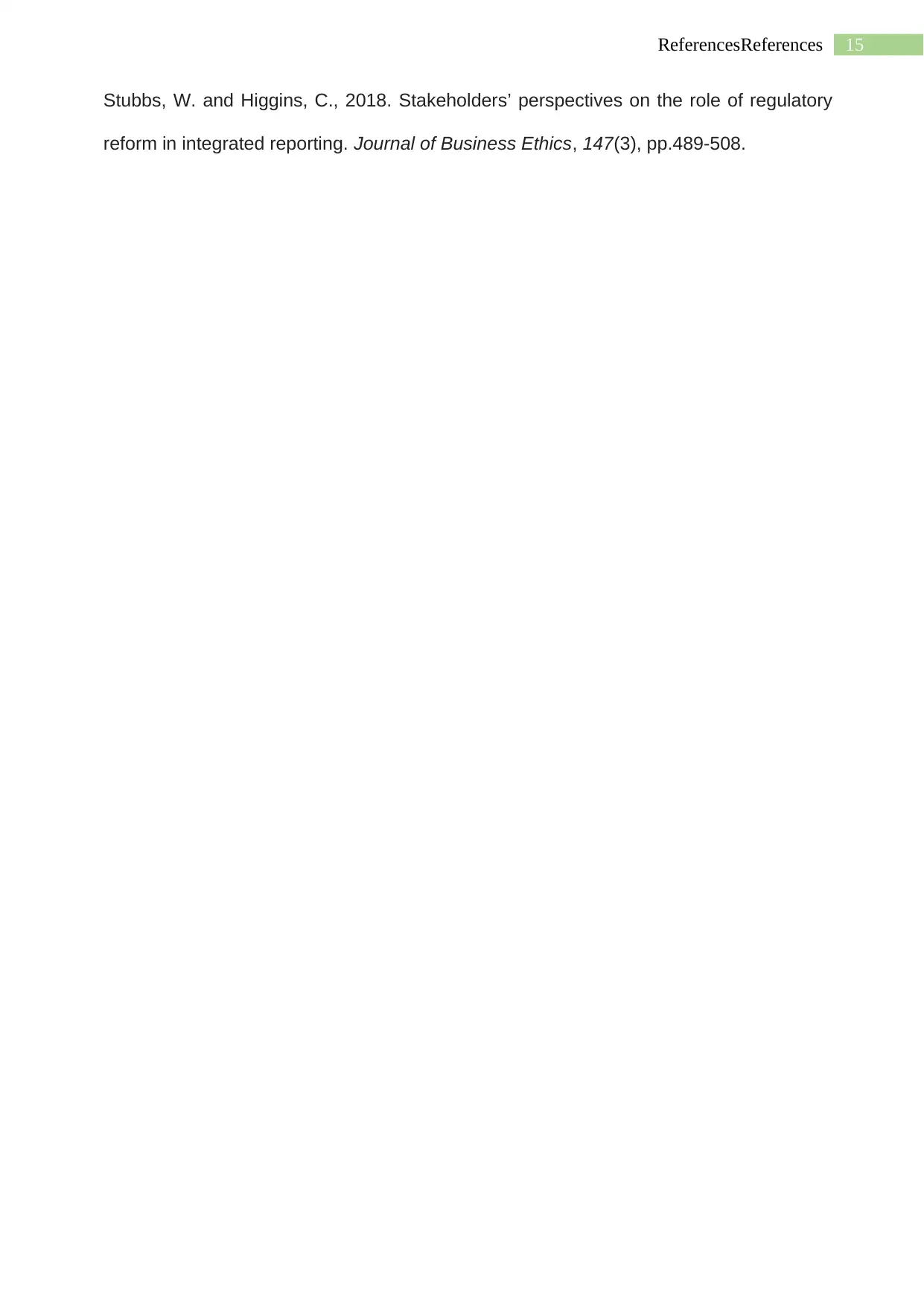
15ReferencesReferences
Stubbs, W. and Higgins, C., 2018. Stakeholders’ perspectives on the role of regulatory
reform in integrated reporting. Journal of Business Ethics, 147(3), pp.489-508.
Stubbs, W. and Higgins, C., 2018. Stakeholders’ perspectives on the role of regulatory
reform in integrated reporting. Journal of Business Ethics, 147(3), pp.489-508.
1 out of 16
Related Documents
Your All-in-One AI-Powered Toolkit for Academic Success.
+13062052269
info@desklib.com
Available 24*7 on WhatsApp / Email
![[object Object]](/_next/static/media/star-bottom.7253800d.svg)
Unlock your academic potential
© 2024 | Zucol Services PVT LTD | All rights reserved.





